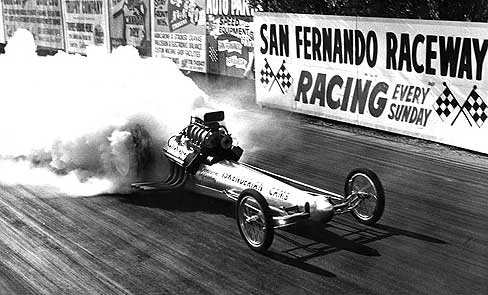| 
BOUND FOR GLORY,
AFTER ALL THESE YEARS

Drag Sport Illustrated liked one of
Wallace’s signature “ladder” photos enough
to enlarge a small print into a tabloid-sized cover shot,
much to the photographer’s surprise. Nearly four decades
later, Dave’s “career shot” was honored
in the prestigious Leslie Lovett Memorial Photo Contest.
8/8/05
 overing a 1960 drag race on deadline was nothing like doing
the job today. What an army of people and equipment do now
— shooting pictures and writing words, armed with laptop
computers and digital cameras — was often accomplished
by a single photojournalist. Accurately recording elapsed
times and speeds was, in itself, a major challenge. Apart
from class records and final-round times, nothing was recorded
for posterity at many tracks. The only place that an ET or
speed was written down was on a time slip — which went
home with the racer.
overing a 1960 drag race on deadline was nothing like doing
the job today. What an army of people and equipment do now
— shooting pictures and writing words, armed with laptop
computers and digital cameras — was often accomplished
by a single photojournalist. Accurately recording elapsed
times and speeds was, in itself, a major challenge. Apart
from class records and final-round times, nothing was recorded
for posterity at many tracks. The only place that an ET or
speed was written down was on a time slip — which went
home with the racer.
Beyond the obvious abilities to write and shoot, this job
further required good ears and strong legs. Imagine sprinting
from the starting line to the nearest speaker pole at the
conclusion of every qualifying run or race, ballpoint pen
and clipboard in hand, straining to hear the numbers announced
over primitive PA speakers. Missing a garbled ET or speed
meant sprinting to the time-slip booth — dodging the
next pair of hot cars pushing down the fire-up road —
to copy the time slip before it rode off in a push truck.
Now, picture our hero loading short rolls of black-and-white
Polaroid film between runs; hand-cranking each exposed sheet
out of a primitive, 1950s-vintage camera body; waiting a full
minute for the image to form; peeling off the film’s
protective cover sheet; swabbing the fresh print with smelly
goop (to prevent the fragile image from fading away); then
finding someplace clean and safe to store it while the sticky
“fixer” dried.
At San Fernando (Calif.) Raceway in the early Sixties, that
busy guy on the starting line was my dad. During the three
hours of weekly open-header time allowed by the young sport’s
first noise curfew, Dave Wallace, Sr. juggled all of these
duties, and more. Anytime the action stopped after an oil-down
or accident, he picked up a broom. Prior to 12:30 p.m. and
after 3:30, he handled trophies for about 40 classes and typed
up track-record certificates, right on the spot. He seldom
left the strip before 6:00 p.m. — and his workday was
far from done.
Once home, after the dishes were done and three kids put
to bed, Dad would organize a large stack of trophy winners’
final-round time slips, then type up a list of class winners
and their respective ETs and speeds for Drag News. Then he’d
bang out an entertaining story, detailing round-by-round action
in Top Fuel, Top Gas and Little Eliminators. Thus did a part-time
job that began with unpacking trophies at 11:00 a.m. extend
until midnight, or even beyond — a lot of time and effort
for 20 bucks’ pay!
“I got the job because I could use a typewriter,”
he explains. “I’d been taking money at the front
gate for a couple of years, so I got to know quite a few of
the regular racers and their families. But the only racing
I saw was when I relieved other people for lunch. Around 1960,
whoever’d been handling record certificates and typing
up the list of class winners went away. They needed someone
who could type, and I did a lot of that at my real job [as
a postal clerk].

|
